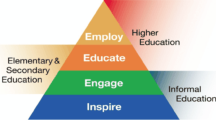Abstract
Amazing Space is a program designed to enhance student mathematics, science, and technology skills using recent data and results from NASA's Hubble Space Telescope mission. The resulting online multi-media resources are designed in a 5-week summer workshop that partners teachers with scientists, graphic artists, writers, and multimedia Web developers. An extensive production cycle including specification, project definition, frequent reviews, and several testing periods has proven to generate robust but flexible resources for classroom use.
Similar content being viewed by others
REFERENCES
American Association for the Advancement of Science. (1993). Benchmarks for Science Literacy. Oxford University Press, New York.
Christian, C.(1998). OPO Educational Resources: The Review Processes for Amazing Space, http://www.stsci.edu/
Gooden, A. (1996). Computers in the Classroom: How Teachers and Students Are Using Technology to Transform Learning, Jossey-Bass, San Francisco.
HDF. (1996). “The Hubble Deep Field Academy,” an online resource at http://www.stsci.edu/amazing-space/hdf
Maslow, A.H. (1998). Toward a Psychology of Being, 3rd ed, Wiley, New York.
National Research Council. (1996). National Science Education Standards, National Academy Press, Washington, DC.
Salomon, G., and Perkins, D. (1996). Learning in wonderland: What do computers really offer education? In Kerr, S. T. (Ed.), Technology and the Future of Schooling, University of Chicago Press, pp. 111–130.
Wiesenmayer, R. L., and Koul, R. (1998). Integrating internet resources into the science classroom: Teachers' perspectives. Journal of Science Education and Technology 7: 271.
Author information
Authors and Affiliations
Rights and permissions
About this article
Cite this article
Christian, C.A., Eisenhamer, B., Eisenhamer, J. et al. Amazing Space: Creating Educational Resources from Current Scientific Research Results from the Hubble Space Telescope. Journal of Science Education and Technology 10, 31–38 (2001). https://doi.org/10.1023/A:1016616510095
Issue Date:
DOI: https://doi.org/10.1023/A:1016616510095




